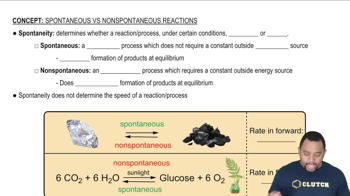Iron corrodes to produce rust, Fe2O3, but other corrosion products that can form are Fe(O)(OH), iron oxyhydroxide, and magnetite, Fe3O4. (a) What is the oxidation number of Fe in iron oxyhydroxide, assuming oxygen's oxidation number is -2? (b) The oxidation number for Fe in magnetite was controversial for a long time. If we assume that oxygen’s oxidation number is - 2, and Fe has a unique oxidation number, what is the oxidation number for Fe in magnetite? (O)(OH), iron oxyhydroxide, and magnetite, Fe3O4. (c) It turns out that there are two different kinds of Fe in magnetite that have different oxidation numbers. Suggest what these oxidation numbers are and what their relative stoichiometry must be, assuming oxygen’s oxidation number is -2.
(a) What is electrolysis? (b) Are electrolysis reactions thermodynamically spontaneous?
 Verified step by step guidance
Verified step by step guidanceKey Concepts
Electrolysis

Spontaneity of Reactions

Gibbs Free Energy

Copper corrodes to cuprous oxide, Cu2O, or cupric oxide, CuO, depending on environmental conditions. (a) What is the oxidation state of copper in cuprous oxide?
Copper corrodes to cuprous oxide, Cu2O, or cupric oxide, CuO, depending on environmental conditions. (c) Copper peroxide is another oxidation product of elemental copper. Suggest a formula for copper peroxide based on its name. (d) Copper(III) oxide is another unusual oxidation product of elemental copper. Suggest a chemical formula for copper(III) oxide.
(c) What process occurs at the anode in the electrolysis of molten NaCl?
(d) Why is sodium metal not obtained when an aqueous solution of NaCl undergoes electrolysis?
(d) Why are active metals such as Al obtained by electrolysis using molten salts rather than aqueous solutions?
